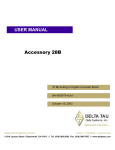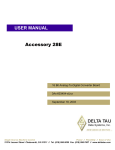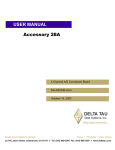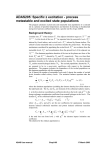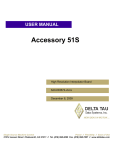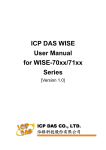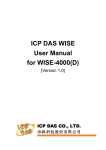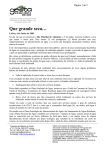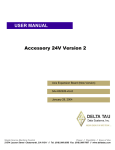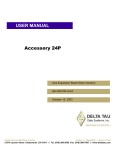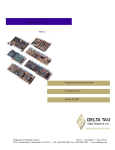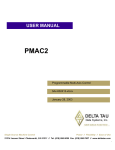Download ^1 USER MANUAL ^2 Accessory 28B
Transcript
^1 USER MANUAL ^2 Accessory 28B ^3 16 Bit Analog to Digital Converter Board ^4 3Ax-602678-xUxx ^5 October 1, 2004 Single Source Machine Control Power // Flexibility // Ease of Use 21314 Lassen Street Chatsworth, CA 91311 // Tel. (818) 998-2095 Fax. (818) 998-7807 // www.deltatau.com Copyright Information © 2003 Delta Tau Data Systems, Inc. All rights reserved. This document is furnished for the customers of Delta Tau Data Systems, Inc. Other uses are unauthorized without written permission of Delta Tau Data Systems, Inc. Information contained in this manual may be updated from time-to-time due to product improvements, etc., and may not conform in every respect to former issues. To report errors or inconsistencies, call or email: Delta Tau Data Systems, Inc. Technical Support Phone: (818) 717-5656 Fax: (818) 998-7807 Email: [email protected] Website: http://www.deltatau.com Operating Conditions All Delta Tau Data Systems, Inc. motion controller products, accessories, and amplifiers contain static sensitive components that can be damaged by incorrect handling. When installing or handling Delta Tau Data Systems, Inc. products, avoid contact with highly insulated materials. Only qualified personnel should be allowed to handle this equipment. In the case of industrial applications, we expect our products to be protected from hazardous or conductive materials and/or environments that could cause harm to the controller by damaging components or causing electrical shorts. When our products are used in an industrial environment, install them into an industrial electrical cabinet or industrial PC to protect them from excessive or corrosive moisture, abnormal ambient temperatures, and conductive materials. If Delta Tau Data Systems, Inc. products are directly exposed to hazardous or conductive materials and/or environments, we cannot guarantee their operation. Accessory 28B Table of Contents INTRODUCTION .......................................................................................................................................................1 Options ......................................................................................................................................................................1 Input Offset Nulling ..................................................................................................................................................2 Things to Know.........................................................................................................................................................2 PMAC AND ACC-28B................................................................................................................................................3 Using Acc-28B in Programs......................................................................................................................................3 PMAC A-D Registers ............................................................................................................................................3 PMAC2 AND ACC-28B..............................................................................................................................................5 Phase Clock Setting Limitation .................................................................................................................................5 ACC-28B WITH ENCODER CONVERSION TABLE OPTIONS ON PMAC AND PMAC2............................7 Unsigned Analog Conversion ...................................................................................................................................7 Converted Data..........................................................................................................................................................7 Encoder Table Entry.............................................................................................................................................7 Encoder Table Usage.................................................................................................................................................7 Non-Turbo Example: ............................................................................................................................................7 Turbo Example: ....................................................................................................................................................8 LAYOUT DIAGRAM AND JUMPERS....................................................................................................................9 Layout Diagram-28B OPT 2A, Connectors and Jumpers .........................................................................................9 Layout Diagram Acc-28B OPT 2B, Connectors and Jumpers ..................................................................................9 Jumpers .....................................................................................................................................................................9 E1 - PMAC Ground ..............................................................................................................................................9 E2..........................................................................................................................................................................9 E3, E4 - PMAC/PMAC2 Select.............................................................................................................................9 E5, E6, E7, E8 - Unipolar/Bipolar Convert..........................................................................................................9 Jumper Table ......................................................................................................................................................10 CONNECTOR PINOUTS.........................................................................................................................................11 J1: Program Header.................................................................................................................................................11 J2: PMAC Interface................................................................................................................................................11 P1: A-D Converter Input ........................................................................................................................................12 TB1: A-D Converter Input (Axes 1 and 2).............................................................................................................13 TB2: A-D Converter (Axes 3 and 4) ......................................................................................................................13 TB3: Power Supply Input.......................................................................................................................................14 Table of Contents i Accessory 28B ii Table of Contents Accessory 28B INTRODUCTION Delta Tau’s Accessory 28B (Acc-28B) is a 2 or 4-channel analog to digital converter interface board (Option 1) designed to provide a means for precision voltage measurement as an input to PMAC and PMAC2. This accessory uses four 16-bit analog-to-digital converters that provide voltage measurements that are accurate to ±2 bits. Jumpers will allow each A-D converter to be selected for Bipolar or Unipolar convert modes. When selected for bipolar mode, differential inputs allow the user to apply input voltages to ±5V (10V p-p) and single-ended inputs allow application of input voltages to +10V. When selected for unipolar mode, differential inputs allow the application of input voltages from 0V to 5V and single-ended inputs allow the application of input voltages from 0V to +10V. In unipolar mode, negative input voltages will not damage the A-D converters. Voltage references are provided for ratiometric style input control. The VREF output is provided for equipment which uses a scaled input for accurate tracking. The +5Vdc and -5Vdc supply taps are less precise and are provided to allow bias potentiometers to be biased without the need for an external power supply. Other features include: Input nulling trimmers are provided to allow for precise adjustment of input signals. Opto-couplers are used to isolate the Acc-28B’s circuitry from the PMAC/PMAC2. When used with PMAC or Acc-24P, each Acc-28B occupies four channels using the PMAC’s JS1 or JS2 interface connector. • When used with PMAC2, each Acc-28B occupies two channels and is connected to an Acc-8T at J2. • When used with PMAC2, all four A-D conversions are simultaneous. • When used with PMAC2, an Acc-8T accessory card is required for connection to signals that are available on the JMACH connector. • Acc-28B requires ±15Vdc. • The Acc-28B comes with mating connectors and a 16-conductor 24” long ribbon cable. • • • When used with PMAC2, the Acc-28B uses the same serial data inputs as is used by digital current loop devices. Therefore, the Acc-28B is not to be used on the same channel pairs as Acc-8K1, Acc-8K2, Acc8F, or other devices which utilize the strobed serial input data lines. Options The Acc-28B is available with the following options: • Option 1: Additional two axes (makes Acc-28B into 4 axis system) • Option 2A: 25-pin DSUB connector at P1. • Option 2B: 10-pin terminal blocks at TB1 and TB2. Note: Select either option 2A or option 2B above. Introduction 1 Accessory 28B Input Offset Nulling Input nulling is performed with the A-D inputs shorted together using Bipolar conversion. If the equipment has output offsets, it is possible to adjust the VR1, VR2, VR3, and VR4 to zero the inputs. The input voltage adjustment swing is limited to approximately 60mV. To adjust nulling, be sure that the temperature has stabilized on the Acc-28B by powering it for about 20 minutes then applying zeroed inputs. Adjust VR1 for channel 1, VR2 for channel 2, VR3 for channel 3, and VR4 for channel 4 for the desired readings on the A-D. When selected for Bipolar conversion, a 0Vdc input should read a number around 32,768 on the A-D input. When selected for Unipolar conversion, the input should be adjusted to 00. Things to Know PMAC performs a sequential conversion of one A-D converter channel at a time. PMAC2 performs a simultaneous conversion of all A-D channels at the same time. Jumpers E3 & E4 select whether the board is addressed by a PMAC or PMAC2, respectively. Be sure to adjust the ADCLK frequency for 1.25MHz. The A-D converters on the ACC28B have a maximum conversion rate of approximately 1.7MHz. 2 Introduction Accessory 28B PMAC AND ACC-28B The A-D CLK jumpers must be adjusted for a conversion value of 1.22MHz. On the PMAC PC, place jumper E98 into position 2-3. Using Acc-28B in Programs The Acc-28B operates by converting data and transmitting it serially to the PMAC. There are eight registers which receive the serial data. These registers may be accessed directly by selection of MVariables. There are subtle addressing differences between PMAC and PMAC2. PMAC references are shown here: PMAC A-D Registers PMAC 1 Turbo PMAC1 ADC # M105->Y:$C006,8,16,U M205->Y:$C007,8,16,U M305->Y:$C00E,8,16,U M405->Y:$C00F,8,16,U M505->Y:$C016,8,16,U M605->Y:$C017,8,16,U M705->Y:$C01E,8,16,U M805->Y:$C01F,8,16,U M105->Y:$78006,8,16,U M205->Y:$78007,8,16,U M305->Y:$7800E,8,16,U M405->Y:$7800F,8,16,U M505->Y:$78106,8,16,U M605->Y:$78107,8,16,U M705->Y:$7810E,8,16,U M805->Y:$7810F,8,16,U 1 2 3 4 5 6 7 8 Connection Connect Acc-28Bs J2 to PMAC’s JS1 Connect Acc-28Bs J2 to PMAC’s JS2 On PMAC, M-Variables are ideal for passing the A-D values into programs. The following is an example of a program that displays the value of A-D input #1 on an LCD display (Acc-12): OPEN PLC1 CLEAR DISPLAY 0,”A-D VALUE IS WHILE (0<1) DISPLAY 14, 5.0, M105 ENDWHILE CLOSE PMAC and Acc-28B “ ; DISPLAY HEADER. ; CREATE LOOP. ; DISPLAY A-D DATA. 3 Accessory 28B 4 PMAC and Acc-28B Accessory 28B PMAC2 AND ACC-28B The A/D clock must be adjusted to operate at 1.25MHz. On PMAC2 models, this is accomplished by adjusting the value of I903 and/or I907. On Turbo PMAC2 models, adjust the A/D clock with the I7m03 variable (where m stands for the Servo IC number). If no other values of clock are to be adjusted on the PMAC2, set I903/I907/I7m03 to a value of 2770. Refer to the PMAC2 Software Addendum manual for details on setting the I903 and/or I907 variables and refer to the Turbo PMAC/PMAC2 Software Reference Manual for the details of the I7m03 setting. The PMAC2 A-D registers are listed below: PMAC2 Hardware Address Turbo PMAC2 Memory Address Name 1st A-D Channel 2nd A-D Channel 3rd A-D Channel 4th A-D Channel Y:$C005,8,16,U Y:$C006,8,16,U Y:$C00D,8,16,U Y:$C00E,8,16,U Y:$78005,8,16,U Y:$78006,8,16,U Y:$7800D,8,16,U Y:$7800E,8,16,U ADC1A ADC1B ADC2A ADC2B 5th A-D Channel 6th A-D Channel 7th A-D Channel 8th A-D Channel Y:$C015,8,16,U Y:$C016,8,16,U Y:$C01D,8,16,U Y:$C01E,8,16,U Y:$78015,8,16,U Y:$78016,8,16,U Y:$7801D,8,16,U Y:$7801E,8,16,U ADC3A ADC3B ADC4A ADC4B 9th A-D Channel 10th A-D Channel 11th A-D Channel 12th A-D Channel Y:$C025,8,16,U Y:$C026,8,16,U Y:$C02D,8,16,U Y:$C02E,8,16,U Y:$78105,8,16,U Y:$78106,8,16,U Y:$7810D,8,16,U Y:$7810E,8,16,U ADC5A ADC5B ADC6A ADC6B 13th A-D Channel 14th A-D Channel 15th A-D Channel 16th A-D Channel Y:$C035,8,16,U Y:$C036,8,16,U Y:$C03D,8,16,U Y:$C03E,8,16,U Y:$78115,8,16,U Y:$78116,8,16,U Y:$7811D,8,16,U Y:$7811E,8,16,U ADC7A ADC7B ADC8A ADC8B Example: A PLC program must read the value from the third A-D channel (ADC2A). 1. Assign an M-variable to point to ADC2A: M205->Y:$C00D,8,16,U I903=2770 ;For non-Turbo PMAC2 ;Set Clock to 1.23 MHz or M205->Y:$7800D,8,16,U I7003=2770 ;For Turbo PMAC2 ;Set Clock to 1.23 MHz 2. When referenced, M205 will equal the value in ADC2A. Save the M-variables after they have been assigned. Phase Clock Setting Limitation When using the Acc-28B the user must be aware of certain limitations. The first limitation is the ADC clock rate. For this product, the maximum ADC clock rate is 1.2MHz. This leads to the next limitation that is the maximum rate at which it can be sampled. The data is sampled during the phase clock. When the phase clock goes from low to high, it is strobed and then the data must be latched by the time phase clock goes from high to low. PMAC2 and Acc-28B 5 Accessory 28B PWM Counter 0 Ring/Phase Clock Strobe Latch The data from the ADC comes from a 24-bit register and each bit will be processed every ADC clock cycle. Therefore, it will take a minimum of 24 ADC clock cycles to return the proper ADC value to the PMAC. So, if we are limited to 1.2MHz ADC clock and it takes 24 cycles to read the data, then the minimum of 20 µsec* is needed to read the data. The 20 µsec represents the time from the strobe to the latch of the phase clock. To have a phase clock on time of about 20 µsec, set the phase clock to about 24 KHz. 24KHz is the maximum phase clock frequency that can be set in the PMAC2 when using Acc-28B. *The 20 µsec is calculated by taking 1.2Mhz/24 cycles. 6 PMAC2 and Acc-28B Accessory 28B ACC-28B WITH ENCODER CONVERSION TABLE OPTIONS ON PMAC AND PMAC2 The encoder conversion table can be modified using either PMAC’s Executive Program Encoder Conversion Table dialog box or the on-line commands in Executive terminal mode. The Encoder Conversion Table is used when motor position is desired from A-D inputs. Refer to the PMAC Software User manual for Encoder Conversion Table uses and applications. Unsigned Analog Conversion The A-D converters on the Acc-28B return unsigned data to a PMAC or PMAC2. If bit 19 of the analog conversion setup word is set to 1 ($18xxxx for normal analog), then PMAC/PMAC2 treats the A-D number in the high 16 bits of the source word (left-justified of 24 bits) as an unsigned number in the range of 0 to 65535. Unsigned analog conversion requires PMAC or PMAC2 Firmware release Version 1.16 or newer to accommodate unsigned A-D input values. A typical setup word for this type of feedback is $18C005 for non-Turbo or $1F8005 for Turbo, which provides for a non-filtered unsigned left-justified conversion of the data word fed by A-D #1 of the Acc28B connected to PMAC. Converted Data The converted data from the parallel word is put in the X data word of the encoder table entry. This address is used by programs and PMAC pointers for the A-D value. For instance, if the first setup entry (address Y:$0720) in the conversion table were $18C005, the result would be left-shifted at address X:$720. For Turbo PMAC, if the first encoder conversion table entry (address Y:$003501) in the conversion table were $1F8005, the result would be left-shifted at address X:$3501. Encoder Table Entry X-Words Y-words Latched data: Unsigned 16 bit word Source and process Bits 0-15: Address of source data Bits 16-23: = $18 Encoder Table Usage Using the above table entry example, an encoder address may be set to point to the X memory side of the table. This allows the sampling of data inside a servo/phase interrupt routine. Non-Turbo Example: The encoder table entry is placed at memory address Y:$0720 (as in previous converted data statement), $18C006: WY:$720,$18C006 The encoder address (Ix03, Ix04) is set to look at the converted result in the Encoder Table: I103 = $720 Acc-28B with Encoder Conversion Table Options on PMAC & PMAC2 7 Accessory 28B Turbo Example: For the Turbo PMAC, set up the encoder conversion table with direct writes to the I-variables (ECT is located at I8000 to I8191). I8000=$1F8005 The encoder address (Ix03, Ix04) is set to look at the converted result in the encoder table: I103 = $3501 For PMAC2 (optionally for PMAC), create an encoder table entry for each A-D input that is to be used. On PMAC2, this is a requirement since the circuitry used for A-D conversion is not accessed synchronously with a PLC program. 8 Acc-28B with Encoder Conversion Table Options on PMAC & PMAC2 Accessory 28B LAYOUT DIAGRAM AND JUMPERS 0.125" 0.000" 4.775" 9.395" Layout Diagram-28B OPT 2A, Connectors and Jumpers 0.125" DIA (typ) 0.125" 0.000" PLACE SIP IN EITHER E3 OR E4 E3 PMAC1 E4 PMAC2 J2 E5 3 1 E7 1-2 UNIPOLAR 2-3 BIPOLAR E1 3 1 E6 1-2 UNIPOLAR 2-3 BIPOLAR 1-2 UNIPOLAR 2-3 BIPOLAR 3 1 E8 1-2 UNIPOLAR 2-3 BIPOLAR E2 3 TB3 1 VR3 VR2 VR4 P1 VR1 0.000" 4.675" 2.575" 2.700" Layout Diagram Acc-28B OPT 2B, Connectors and Jumpers PLACE SIP IN EITHER E3 OR E4 E3 PMAC1 E4 PMAC2 J2 E5 3 1 E7 1-2 UNIPOLAR 2-3 BIPOLAR E1 3 1 E6 1-2 UNIPOLAR 2-3 BIPOLAR 1-2 UNIPOLAR 2-3 BIPOLAR 3 1 E8 1-2 UNIPOLAR 2-3 BIPOLAR E2 3 TB3 1 VR2 TB1 VR3 VR4 TB2 VR1 Jumpers Refer to the previous layout diagram for the location of the jumpers on the board. A position listing for each jumper is provided in this section. E1 - PMAC Ground This jumper is used to connect PMAC’s ground to the power supply ground. E2 Not used. E3, E4 - PMAC/PMAC2 Select This SIP jumper selects whether the Acc-28B is connected to PMAC or PMAC2. When connected to PMAC, data conversion occurs one channel at a time. When connected to PMAC2, data is simultaneously converted for all four channels. E5, E6, E7, E8 - Unipolar/Bipolar Convert These jumpers allow the selection of the method of A-D conversion for each channel. Position 1-2 allows unipolar conversions, which returns an unsigned value of 0 to 65535 for input voltages ranging from 0 to 10V (approximately). Position 2-3 allows bipolar conversions, which return an unsigned value of 0 to 65535 for input voltages ranging from -10V to +10V (20V pk-pk). Layout Diagram and Jumpers 9 Accessory 28B Jumper Table 10 E Point Pin Layout E1 1-2 E2 E3, E4 1-2-3 SIP socket E5, E6, E7, E8 1-2-3 Description Default Jumper pin 1 to 2 to connect the PMAC/PMAC2 power supply common to the supplied AGND. Spare - unused jumper Place the 10Ω SIP resistors in either socket position. E3 - PMAC1 E4 - PMAC2 Jumper pin 1 to 2 for Unipolar convert. Jumper pin 2 to 3 for Bipolar convert. E7 - Channel #1 E5 - Channel #2 E6 - Channel #3 E8 - Channel #4 1 to 2 on -100 boards; Open on others E3 2 to 3 Layout Diagram and Jumpers Accessory 28B CONNECTOR PINOUTS J1: Program Header This is used only at the factory. J2: PMAC Interface This 16-pin box header attaches the Acc-28B to PMAC’s JS1 or JS2 connector. On PMAC2, J2 is connected to J2 on the Acc-8T. Pin # Symbol Function Description Notes 1 DCLK Input A-D converter clock 2 n.c. Not connected 3 ASEL0Input PMAC address select Not on PMAC2 4 ASEL1Input PMAC address select Not on PMAC2 5 CONV Input Start convert 6 ADCIN1 Output PMAC serial data Not on PMAC2 7 n.c. Not connected 8 n.c. Not connected 9 n.c. Not connected 10 n.c. Not connected 11 ADC0 Output PMAC2 serial data Channel 1 PMAC2 only* 12 ADC1 Output PMAC2 serial data Channel 2 PMAC2 only* 13 ADC2 Output PMAC2 serial data Channel 3 PMAC2 only* 14 ADC3 Output PMAC2 serial data Channel 4 PMAC2 only* 15 +5V PMAC/PMAC2 +5V 16 GND PMAC/PMAC2 GND *These terminals are disconnected when jumper E3 is selected (PMAC1 configuration). Connector Pinouts 11 Accessory 28B P1: A-D Converter Input This 25-pin DSUB contains the inputs and reference outputs for the ACC28B. The reference taps are ±5Vdc, 4.096Vdc (VREF) and RET. This is available with Option 2A only. Pin # Symbol Function Description Notes 1 ADC1+ Input A-D converter channel 1+ 2 ADC1Input A-D converter channel 15 3 ADC2+ Input A-D converter channel 2+ 4 ADC2Input A-D converter channel 25 5 ADC3+ Input A-D converter channel 3+ 1 6 ADC3Input A-D converter channel 31, 5 7 ADC4+ Input A-D converter channel 4+ 1 8 ADC4Input A-D converter channel 41, 5 9 n.c. 10 n.c. 11 VREF Output 4.096Vdc precision reference 2 12 +5Vdc Output +5V reference output 3 13 -5Vdc Output -5V reference output 3 14 SHIELD Gnd Shield 4 15 SHIELD Gnd Shield 4 16 SHIELD Gnd Shield 4 17 SHIELD Gnd Shield 4 18 SHIELD Gnd Shield 4 19 SHIELD Gnd Shield 4 20 SHIELD Gnd Shield 4 21 SHIELD Gnd Shield 4 22 n.c. Not connected 23 n.c. Not connected 24 RET Gnd VREF return 4 25 RET Gnd 4 ±5Vdc return 1. These signals exist on Option 1 (4-channel) boards only. 2. This is a buffered tap from the A-D precision reference. Typically, external hardware that uses this signal reference will scale it for a full-scale A-D voltage input. 3. +5Vdc and -5Vdc are a less precise A-D reference. When used with an A-D input in the unipolar mode, it is possible to get approximately full-scale inputs. This requires the -5Vdc to be connected to the ADCx- input (ideal for metering potentiometers). 4. The shields are connected internally to the ground plane inside the Acc-28B. Normally, shields are connected at one end of the wire only (this eliminates possible system ground loops). In addition, the VREF and ±5Vdc return lines are connected to the internal ground plane. 5. For single-ended inputs, ADCn should be connected to GND at pin24 or 25. 12 Connector Pinouts Accessory 28B TB1: A-D Converter Input (Axes 1 and 2) This 10-pin terminal block contains the inputs for channel 1 and channel 2. Reference outputs of ±5Vdc, 4.096Vdc (VREF) and RET (AGND) are provided on this connector. This is available with Option 2B only. Pin # Symbol Function Description Notes 1 ADC1+ Input A-D converter Channel 1+ 2 ADC1Input A-D converter Channel 14 3 AGND Gnd Shield 1 4 ADC2+ Input A-D converter Channel 2+ 5 ADC2Input A-D converter Channel 24 6 AGND Gnd Shield 1 7 VREF Output 4.096Vdc precision reference 2 8 AGND Gnd 1 9 +5Vdc Output +5V reference output 3 10 -5Vdc Output -5V reference output 3 1. The shields are connected internally to the ground plane inside the Acc-28B. Normally, shields are connected at one end of the wire only (this eliminates possible system ground loops). Also the PIN 8 AGND line is connected to the internal ground plane. 2. This is a buffered tap from the A-D precision reference. Typically, external hardware that uses this signal reference will scale it for a full-scale A-D voltage input. 3. +5Vdc and -5Vdc are a less precise A-D reference. When used with an A-D input in the unipolar mode, it is possible to get approximately full-scale inputs. This requires the -5Vdc to be connected to the ADCx- input (ideal for metering potentiometers). 4. For single-ended inputs, ADCn should be connected to GND at pin 3, 6 or 8. TB2: A-D Converter (Axes 3 and 4) This 10-pin terminal block contains the inputs for channel 3 and channel 4. Reference outputs of ±5Vdc, 4.096Vdc (VREF) and RET (AGND) are provided on this connector. This is available with Options 1 and 2B only. Pin # Symbol Function Description Notes 1 ADC3+ Input A-D converter Channel 3+ 2 ADC3Input A-D converter Channel 34 3 AGND Gnd Shield 1 4 ADC4+ Input A-D converter Channel 4+ 5 ADC4Input A-D converter Channel 44 6 AGND Gnd Shield 1 7 VREF Output 4.096Vdc precision reference 2 8 AGND Gnd 1 9 +5Vdc Output +5V reference output 3 10 -5Vdc Output -5V reference output 3 1. The shields are connected internally to the ground plane inside the Acc-28B. Normally, shields are connected at one end of the wire only (this eliminates possible system ground loops). In addition, the pin 8 AGND line is connected to the internal ground plane. 2. This is a buffered tap from the A-D precision reference. Typically, external hardware that uses this signal reference will scale it for a full-scale A-D voltage input. 3. +5Vdc and -5Vdc are a less precise A-D reference. When used with an A-D input in the unipolar mode, it is possible to get approximately full-scale inputs. This requires the -5Vdc to be connected to the ADCx- input (ideal for metering potentiometers). 4. For single-ended inputs, ADCn should be connected to GND at pin 3, 6 or 8. Connector Pinouts 13 Accessory 28B TB3: Power Supply Input Pin # 1 2 3 4 1. 2. 14 Symbol Function Description Notes AGND Common Power supply return N.C. Not connected +15Vdc Input +15V power input 1 -15Vdc Input -15V power input 2 +15Vdc requires a 200mA supply current. However, if the supply or reference taps at P1, TB1 or TB2 are used and the current requirement may be greater. -15Vdc requires 70mA supply current. However, if the supply taps at P1, TB1 or TB2 are used and the current requirement may be greater. Connector Pinouts


















